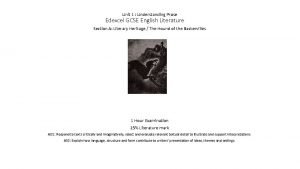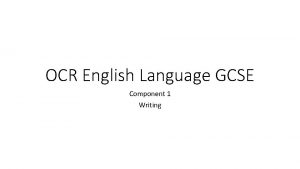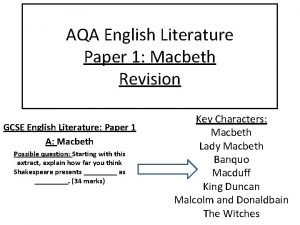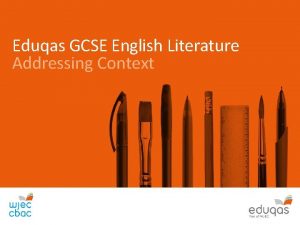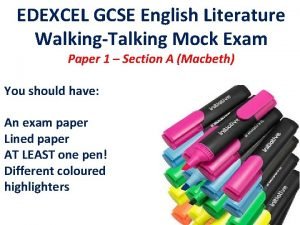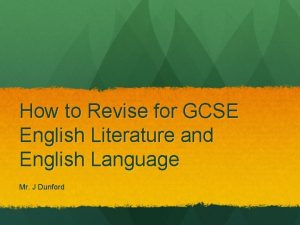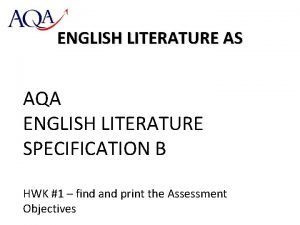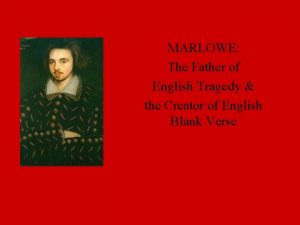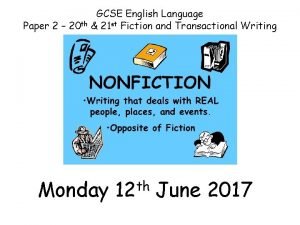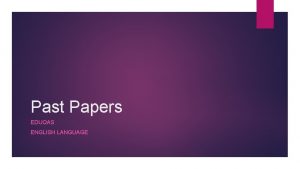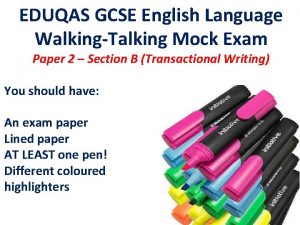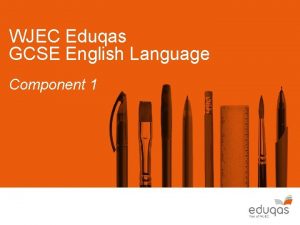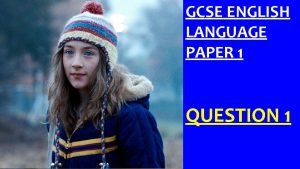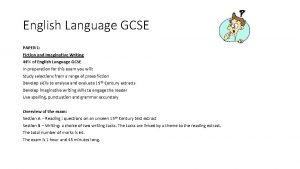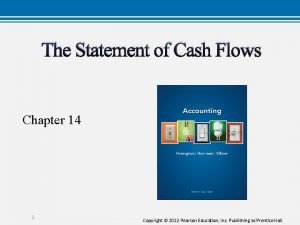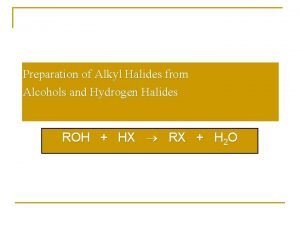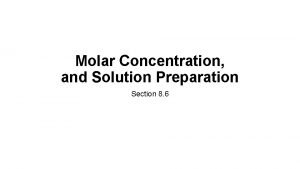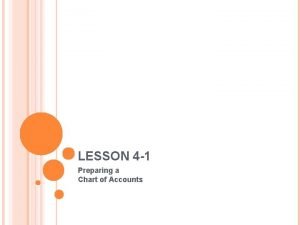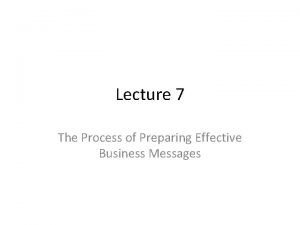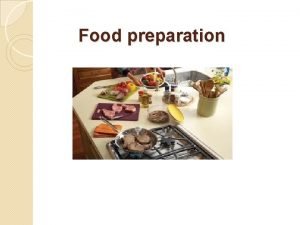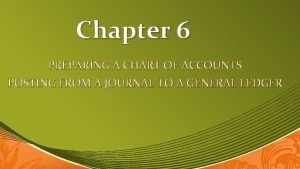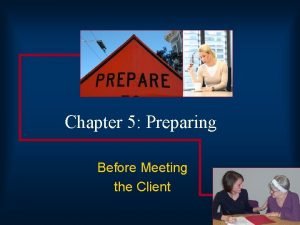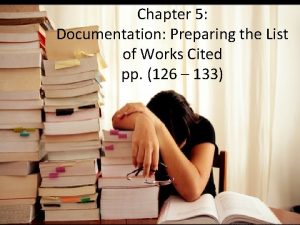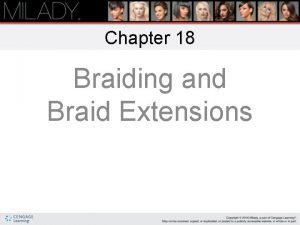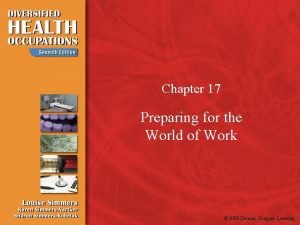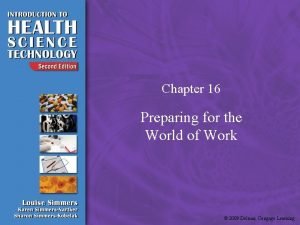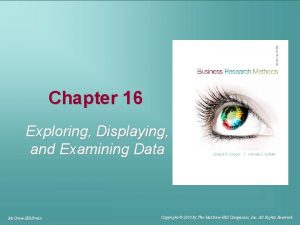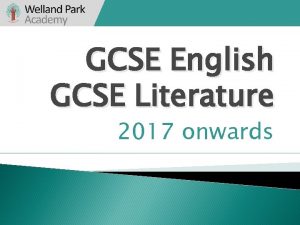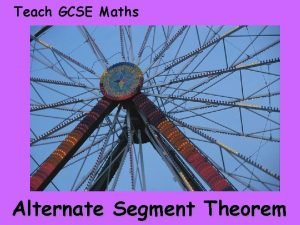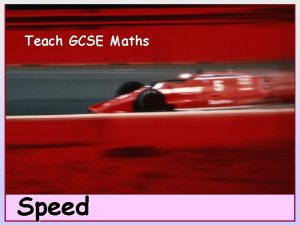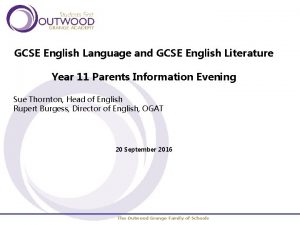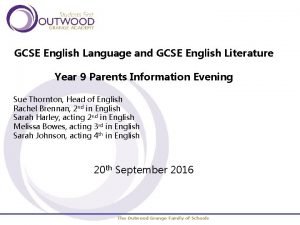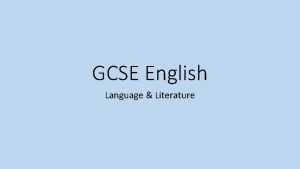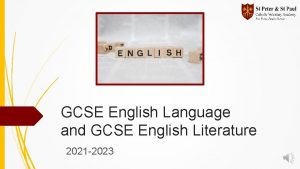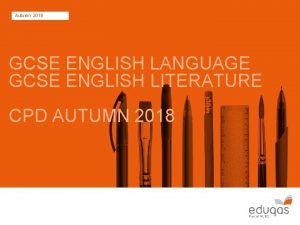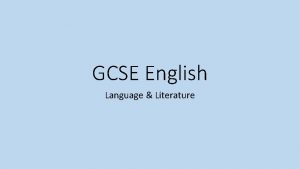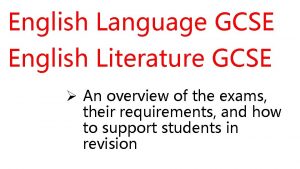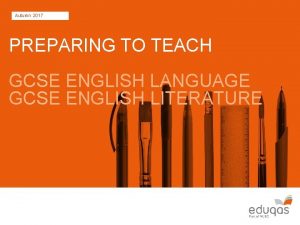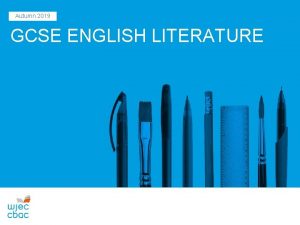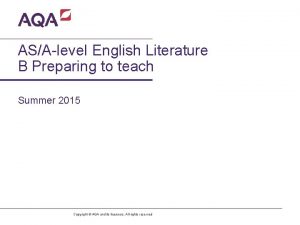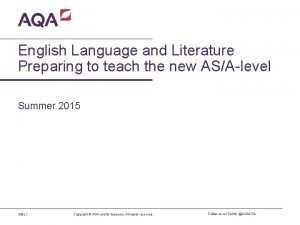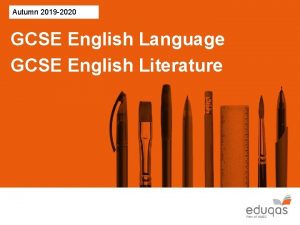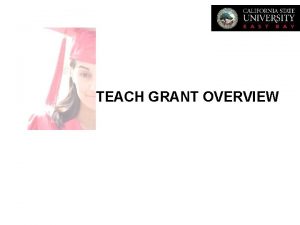Preparing to teach GCSE English Literature 1 of









































- Slides: 41

Preparing to teach: GCSE English Literature 1 of x Copyright © AQA and its licensors. All rights reserved. Follow us on Twitter @AQA.

An opportunity to explore in more detail: • • 2 of x an overview of both papers the importance of extract-to-whole assessment (Paper 1 Sections A and B) textual “references” and assessment of AO 1 and AO 2 in closed-book conditions comparison of seen (Paper 2 Section B) and unseen (Paper 2 Section C) poetry.

English Literature specification at a glance 3 of x Copyright © AQA and its licensors. All rights reserved.

English Literature specification 4 of x Copyright © AQA and its licensors. All rights reserved.

Assessment Objective 1 5 of x Copyright © AQA and its licensors. All rights reserved.

Assessment Objective 2 6 of x Copyright © AQA and its licensors. All rights reserved.

Assessment Objective 3 7 of x Copyright © AQA and its licensors. All rights reserved.

Assessment Objective 4 8 of x Copyright © AQA and its licensors. All rights reserved.

Comparison “In each specification as a whole, 20 -25% of the marks should require candidates to show the abilities described in AO 1, AO 2 and AO 3 through tasks which require them to make comparisons across texts. ” 9 of x Copyright © AQA and its licensors. All rights reserved.

Defining Context (AO 3) AO 3 is the understanding of the relationship between the ideas in the text and the contexts of the text. The range of contexts and relationships that is most relevant as part of AO 3 will depend on the text, the author and the task. In teaching and assessing AO 3, teachers and students can consider context in a flexible way, dependent on the text itself and whichever contexts are the most relevant for that particular text. These contexts may relate to the relationship between the text and the context in which it was written. However, these contexts may also relate to the context within which the text is set: location, social structures and features, cultural contexts, and periods in time. Context, where relevant, may also apply to literary contexts such as genres. It may also apply to the contexts in which texts are engaged with by different audiences. 10 of x

Context in questions • Starting with this speech, explain how far you think Shakespeare presents Macbeth as a hero. • At the start of Lord of the Flies, Piggy asks Ralph: ‘Aren’t there any grownups at all? ’ How does Golding present ideas about being a ‘grown-up’ in Lord of the Flies? 11 of x

Paper 1: Extract to whole assessment 12 of x

A holistic response to Paper 1 assessments Candidates can: • • spend more time on the extract or, spend more time on the whole write about the extract and then the whole approach both together at the same time. The response is marked as a whole. There is not a separate mark allocation for either of the two bullet points. 13 of x

A Skills Hierarchy: Level Descriptor 6 • • • Critical, exploratory, well-structured approach to task and whole text Conceptualised approach supported by judicious references from text Insightful analysis of language, structure and form 5 • • • Thoughtful, developed consideration of task and whole text References from text integrated into interpretation Detailed examination of effects of writer’s methods 4 • • • Clear, sustained understanding of task and whole text References from text used to support explanation Clear explanation of effects of range of writer’s methods 3 • • • Explained response to task and whole text Supported by range of relevant references to text Identification of effects of range of writer’s methods 2 • • • Supported, relevant comments on task and text Relevant references to text Identification of writer’s methods 1 • • • Simple, explicit comments showing awareness of task and text Narrative / descriptive references to text Awareness of writer making choices 14 of x

One way of approaching an extract To engage students in similar ways to how they might approach extracts in the GCSE English Language papers: • • • 15 of x what are the main ideas , themes or character that is being introduced, or developed? how do particular choices of words/phrases/ or lines within the extract affect the reader? why is the writer seeking to have this effect at this particular point in the play or novel? what other parts, or key pivotal moments of the text does it suggest? when I read this, what do I think is important? How does it add to, reinforce or change how I think about the character, relationships, themes or ideas that I have been studying?

One way of approaching an extract Read the following extract from Act 3 Scene 2 of Romeo and Juliet and then answer the question that follows. At this point in the play Juliet is waiting for the Nurse to come back from meeting Romeo. Starting with this speech, explore how Shakespeare uses language to present attitudes towards love in Romeo and Juliet. Write about: • what Juliet says about love in this speech • how Shakespeare uses language to present attitudes to love in the play as a whole. 16 of x

Romeo and Juliet extract JULIET Come, night; come, Romeo; come, thou day in night; For thou wilt lie upon the wings of night Whiter than new snow on a raven's back. Come, gentle night, come, loving, black-brow'd night, Give me my Romeo; and, when he shall die, Take him and cut him out in little stars, And he will make the face of heaven so fine That all the world will be in love with night And pay no worship to the garish sun. O, I have bought the mansion of a love, But not possess'd it, and, though I am sold, Not yet enjoy'd: so tedious is this day As is the night before some festival To an impatient child that hath new robes And may not wear them. O, here comes my nurse, And she brings news; and every tongue that speaks But Romeo's name speaks heavenly eloquence. 17 of x

Romeo and Juliet extract JULIET Come, night; come, Romeo; come, thou day in night; For thou wilt lie upon the wings of night Whiter than new snow on a raven's back. Come, gentle night, come, loving, black-brow'd night, Give me my Romeo; and, when he shall die, Take him and cut him out in little stars, And he will make the face of heaven so fine That all the world will be in love with night And pay no worship to the garish sun. O, I have bought the mansion of a love, But not possess'd it, and, though I am sold, Not yet enjoy'd: so tedious is this day As is the night before some festival To an impatient child that hath new robes And may not wear them. O, here comes my nurse, And she brings news; and every tongue that speaks But Romeo's name speaks heavenly eloquence. 18 of x

One teacher’s approach to teaching extract to whole assessment • 19 of x A video is available on the AQA website to show a teacher does this in the classroom.

Paper 2 Section A 20 of x Approaches to textual references and assessment of AO 1/AO 2 in closed-book conditions…

Paper 2 Section A How does Priestley present some of the differences between the older and younger generations in An Inspector Calls? Write about: • how the different generations respond to events and to each other • how Priestley presents the different generations in the play. Activity: Use the mark scheme to rank order the two responses: • • which makes more useful references to the text? which response shows that the candidate has better engagement with the question, and text? 21 of x

A Skills Hierarchy Level Descriptor 6 • • • Critical, exploratory, well-structured approach to task and whole text Conceptualised approach supported by judicious references from text Insightful analysis of language, structure and form 5 • • • Thoughtful, developed consideration of task and whole text References from text integrated into interpretation Detailed examination of effects of writer’s methods 4 • • • Clear, sustained understanding of task and whole text References from text used to support explanation Clear explanation of effects of range of writer’s methods 3 • • • Explained response to task and whole text Supported by range of relevant references to text Identification of effects of range of writer’s methods 2 • • • Supported, relevant comments on task and text Relevant references to text Identification of writer’s methods 1 • • • Simple, explicit comments showing awareness of task and text Narrative / descriptive references to text Awareness of writer making choices 22 of x

An Inspector Calls sample responses Priestley shows lots of differences between the older and younger generations in An Inspector Calls. At the start of the play Mr Birling spends a lot of time saying what he thinks and giving advice. He says: ‘there is a lot of silly talk about these days’ about the war. He also says that ‘we’ve passed the worst of it’. This shows that he isn’t right because the war happened, so Priestley is showing that Mr Birling isn’t going to be right about anything. He then gives another long speech to Eric and Gerald. He says; ‘you’ve a lot to learn yet. ’ This makes him sound as if he thinks he’s better than Eric and Gerald. He also says that he is a ‘hard-headed man of business’. Then he says; ‘a man has to mind his own business and look after himself and his own’. His famous quote is about the Titanic where he says ‘unsinkable, absolutely unsinkable’. At the end of the play he says ‘the whole story’s just a lot of moonshine’. He also says ‘the famous younger generation who know it all. And they can’t even take a joke. ’ Mrs Birling is the same because she tries to say that Eric and Sheila are just tired at the end of the play as if they are just children. ‘They’re over-tired’. Sheila and Eric are different because they learn things from the Inspector. Eric learns because he says ‘we helped to kill her’ and Sheila says ‘I suppose we’re all nice people now’. 23 of x

An Inspector Calls sample responses In An Inspector Calls, Priestley uses the contrast between the younger and older generations to explore his ideas about society and responsibility. As the play progresses, the contrast gets more extreme. At the start of the play, Eric is shown to be irresponsible through the presentation of him as a drinker. Sheila is getting engaged and is shown to be very excited about her engagement ring, although Priestley uses stage directions to hint that there is a more serious side to her ‘half serious, half playful’. Because of what we later find out about Gerald and his similarity to Mr Birling, this direction shows that Sheila is quite wise and has good instincts. On the other hand Mr Birling is shown to have very bad instincts in Act One. He keeps telling the ‘youngsters’ to listen to him, as if he is drawing attention to the wisdom of his years and experience. This repetition forces the audience to pay attention to the differences between the older and younger generations, as if Priestley is indicating that this is an important idea in the play. This is then highlighted even further with Mr Birling’s confident statements about the Titanic and the War: ‘unsinkable, absolutely unsinkable’ and ‘The Germans don’t want war’. These statements in particular allow Priestley to demonstrate the arrogance of people like Birling who think they know it all but are completely wrong. The language Birling uses is blunt and to the point, as if there is no room for argument in what he thinks. However, Priestley is using irony here to show wrong he is and therefore not to be trusted, in contrast with Sheila who has very good instincts. 24 of x

An Inspector Calls sample responses In An Inspector Calls, Priestley uses the contrast between the younger and older generations to explore his ideas about society and responsibility. As the play progresses, the contrast gets more extreme. At the start of the play, Eric is shown to be irresponsible through the presentation of him as a drinker. Sheila is getting engaged and is shown to be very excited about her engagement ring, although Priestley uses stage directions to hint that there is a more serious side to her ‘half serious, half playful’. Because of what we later find out about Gerald and his similarity to Mr Birling, this direction shows that Sheila is quite wise and has good instincts. On the other hand Mr Birling is shown to have very bad instincts in Act One. He keeps telling the ‘youngsters’ to listen to him, as if he is drawing attention to the wisdom of his years and experience. This repetition forces the audience to pay attention to the differences between the older and younger generations, as if Priestley is indicating that this is an important idea in the play. This is then highlighted even further with Mr Birling’s confident statements about the Titanic and the War: ‘unsinkable, absolutely unsinkable’ and ‘The Germans don’t want war’. These statements in particular allow Priestley to demonstrate the arrogance of people like Birling who think they know it all but are completely wrong. The language Birling uses is blunt and to the point, as if there is no room for argument in what he thinks. However, Priestley is using irony here to show wrong he is and therefore not to be trusted, in contrast with Sheila who has very good instincts. 25 of x

The English e-Library Because English is so much more than words on paper. • • • 26 of x Allows your students to interact with texts in new and exciting ways. Packed with bespoke audio, video and image content, lesson plans and teaching ideas. Customisable resources - highlight texts, search for keywords, add and save annotations, link resources and add weblinks, share with individuals and groups. Authoritative content created for teachers, by teachers. Video clips can be used on and offline to introduce lessons, as homework, or as models for students to create their own content. Available exclusively and free of charge to those to commit to teaching with us. Copyright © AQA and its licensors. All rights reserved.

Paper 2 Section B: Comparison of studied poems To help, we: • • list the titles of poems in each cluster on the exam paper as a key reminder print the poem named in the question on the exam paper. Students need to: • • know their chosen cluster of poems holistically be able to make connections and comparisons between the poems and theme of the cluster. Students will need help to: • • • use the named poem for close AO 2 references in particular focus on the named poem printed for them in the question paper as a starting point consider how best to reference their own choice of poem for the purpose of comparison. 27 of x

Activity 1. Look at this question from the first set of specimen papers: Compare the ways poets present ideas about power in ‘Ozymandias’ and in one other poem from ‘Power and conflict’. 2. How is this student making effective references to the poems? See response in your pack. 3. Now look briefly at the questions in the second set of specimen papers: How are they establishing a similar degree of support for students to address AO 1 and AO 2? 28 of x

Activity Both ‘Ozymandias’ and ‘My Last Duchess’ show the effects of power and how it corrupts. Shelley describes Ozymandias’ ‘sneer of cold command’ as if to suggest that he is a cruel and heartless leader, only concerned with his own power and the immortality it will bring. The Duke in ‘My Last Duchess’ is similarly concerned with his own power and status. Although the monologue is supposed to replicate a conversation, there is no opportunity for his listener to speak – Browning writes the monologue to show the Duke’s self-obsession and that he is not interested in anyone’s views other than his own. Ozymandias might have had ‘cold command’ of his ‘lands’, just like the Duke ‘gave commands’. Both poets are concerned with the effects of power and how in the wrong hands it corrupts. The Duke is shown to be misguided as Browning uses imagery to hint at the Duchess’ kindness and gentle spirit (white pony) to prove that she is innocent and has been killed for nothing. Ozymandias is shown to also be cruel: ‘sneer of cold command’ – however he has been left with nothing: ‘the lone and level sands stretch far away’. It could be argued that the Duke has also been left with nothing: he has a statue of ‘Neptune’ which is made of cold bronze. He doesn’t realise this himself however, as he cares nothing for human relationships and is far more concerned, like Ozymandias, with his pride and reputation. Ultimately both leaders are shown by the poets to be corrupt. Both poets feel that power in the wrong hands has devastating consequences on the innocent. However, although both poets show that this corruption is punished in the end, perhaps it is the Duke who is shown more clearly to be the true despot as Browning uses the dramatic monologue to show first hand how completely self absorbed he is. 29 of x

Paper 2 Section C: Comparison of unseen poetry Students do really well, and seem to enjoy, responding to unseen poems. The response to unseen is the final task. In this way, it gives students the opportunity to demonstrate and use the skills they have learned throughout the course in a ‘synoptic’ way. Comparison of unseen texts is a requirement of the qualification. However, this element of the qualification is worth 8 marks out of a total of 168. As students respond to the first unseen poem, they are mentally gathering ideas to use in the final 8 mark task. Both poems will have very clear links and connections in terms of ideas. The final 8 mark task will also make these main links and connections explicit. 30 of x

Paper 2 Section C: Comparison of unseen poetry How to Leave the World that Worships Should Let faxes butter-curl on dusty shelves. Let junkmail build its castles in the hush of other people’s halls. Let deadlines burst and flash like glorious fireworks somewhere else. As hours go softly by, let others curse the roads where distant drivers queue like sheep. Let e-mails fly like panicked, tiny birds. Let phones, unanswered, ring themselves to sleep. Above, the sky unrolls its telegram, immense and wordless, simply understood: you’ve made your mark like birdtracks in the sand now make the air in your lungs your livelihood. See how each wave arrives at last to heave itself upon the beach and vanish. Breathe. Ros Barber 31 of x

Sample Task 27. 1 In ‘How to Leave the World that Worships Should, ’ how does the poet present ideas about the way we live and work in the modern world? 32 of x

Activity • Read the question and the poem. • Select three lines / words / phrases that you think are particularly significant. 33 of x

Paper 2 Section C: Comparison of unseen poetry The Rich Eat Three Full Meals The rich eat three full meals, the poor two small bowls But peace is what matters. Thirsty, I drink sweet plum tea; Warm, I lie in the shade, in the breeze; My paintings are mountains and rivers all around me, My damask*, embroidered, the grass. I rest at night, rest easy, Am awake with the sun And enjoying Heaven’s heaped-up favours. Nguyen Binh Khiem 34 of x

Paper 2 Section C: Comparison of unseen poetry 27. 2 In both ‘The Rich Eat Three Full Meals’ and ‘How to Leave the World that Worships Should’, the speakers describe attitudes towards the world around us. What are the similarities and / or differences between the ways the poets present these attitudes? 35 of x

Forming a comparative response Both…. However…. 36 of x

Paper 2 Section C top level three response…? Both speakers are talking about how it is important to enjoy life and see the beauty of the natural world. In ‘The Rich…’ the poet uses positive images to show the beauty of the world for example ‘my paintings are mountains and rivers’ which gives the sense that he sees the world as a work of art and something precious to be admired. In ‘How to’, the poet also uses positive imagery although she uses them to show the power and size of the natural world such as ‘immense and wordless’, as if the natural world is bigger and much more important than the human world. This suggests that Barber sees the natural world as something bigger that we can’t own, but the poet in ‘The Rich’ seems to suggest something different through his images, as if the natural world belongs to humans. This is also suggested by the ways both poets position the idea of ‘peace’. In ‘The Rich’ it is on the second line but Barber puts the word ‘breathe’ right at the end of the poem. Both suggest that it is the main point of their poem however, because in ‘The Rich’ it is a definite statement: ‘peace is what matters’ and in ‘How To’ it is a direct instruction in a single word sentence at the end of the poem. However, although both poems are about similar ideas, ‘How to’ seems more direct and as if it matters more. She uses second person and lots of instructions to the reader in the second verse, whereas ‘The Rich’ just describes his own way of looking at the world. This makes ‘How to’ seem more powerful and direct as if it is very important that we do as she says. 37 of x

Co-teaching our specifications 38 of x Copyright © AQA and its licensors. All rights reserved.

Co-teachable skills AO Skills Planning Opportunities Lang AO 1 Lit AO 1 Having a response to what they read Lang 1 Sec A Lit 1 Sec A, B Lit 2 Sec A Lang AO 2 Lit AO 2 Being able to analyse language and textual references Lang 1 Sec A Lit 1 Sec A, B Lit 2 Sec A, B, C Lang AO 4 Lit AO 1 Developing a more critical response Lang 1 Sec A Lit 1 Sec A, B Lit 2 Sec A, B, C Lang AO 3 Lit AO 2 Being able to compare ideas and texts Lang 2 Sec A Lit 2 Sec B, C 39 of x Copyright © AQA and its licensors. All rights reserved.

Plenary activity Consider how you might co-teach for language and literature skills development: • close reading responses to an extract • critical interpretations • use of a literature set text to give coherence (and content) within a unified course. 40 of x Copyright © AQA and its licensors. All rights reserved.

Further support from AQA • GCSE English subject team: english-gcse@aqa. org. uk / 0161 953 7504 • One hour video presentations of the new GCSE English Language and Literature can be accessed via the AQA website: http: //www. aqa. org. uk/subjects/english/gcse/english-language-specificationlaunch-webcast http: //www. aqa. org. uk/subjects/english/gcse/english-literature-specificationlaunch-webcast • Resources on website for GCSE English Language and English Literature: • planning resources • teaching resources • assessment resources. • Further training courses will be available from autumn 2015 details can be found on the AQA website: www. aqa. org. uk/professional-development 41 of x Copyright © AQA and its licensors. All rights reserved.
 Edexcel gcse english literature
Edexcel gcse english literature Gcse speech example
Gcse speech example English literature gcse edexcel past papers
English literature gcse edexcel past papers English literature paper 1 macbeth
English literature paper 1 macbeth Eduqas english literature specification
Eduqas english literature specification Edexcel gcse english literature model answers
Edexcel gcse english literature model answers Soundcloud download
Soundcloud download Aqa gcse english literature specification
Aqa gcse english literature specification Edexcel gcse english literature past papers
Edexcel gcse english literature past papers Who is father of english drama
Who is father of english drama Teaching english to arabic speakers
Teaching english to arabic speakers Edexcel english language
Edexcel english language Aqa eng lang paper 2
Aqa eng lang paper 2 Ruby lennox extract
Ruby lennox extract Eduqas gcse english language past papers
Eduqas gcse english language past papers Bedfordshire gcse maths
Bedfordshire gcse maths Eduqas creative writing examples
Eduqas creative writing examples Ice swimming in tromso
Ice swimming in tromso Gcse english language paper 1 question 2
Gcse english language paper 1 question 2 Is english language paper 1 fiction or nonfiction
Is english language paper 1 fiction or nonfiction Objectives in making sandwich
Objectives in making sandwich Destiny corporation is preparing its
Destiny corporation is preparing its Preparing for research design
Preparing for research design When preparing an iv solution a technician should work
When preparing an iv solution a technician should work Preparing guest clothes and shoes
Preparing guest clothes and shoes Preparing for revival
Preparing for revival Preparing desserts ppt
Preparing desserts ppt Hydrogen halide
Hydrogen halide Concentration in molarity
Concentration in molarity Process of making apple juice step by step
Process of making apple juice step by step 4-2 on your own p 108
4-2 on your own p 108 The process of preparing effective business messages
The process of preparing effective business messages What does food preparation mean
What does food preparation mean What is meant by primary emulsion
What is meant by primary emulsion Bar chart of accounts
Bar chart of accounts Preparatory arranging social work
Preparatory arranging social work Documentation preparing the list of works cited
Documentation preparing the list of works cited 18:2 writing a cover letter and preparing a resume
18:2 writing a cover letter and preparing a resume Preparing textured hair for braiding
Preparing textured hair for braiding Chapter 17:3 completing job application forms
Chapter 17:3 completing job application forms Chapter 18 preparing for the world of work
Chapter 18 preparing for the world of work Data preparing exploring examining and displaying
Data preparing exploring examining and displaying
